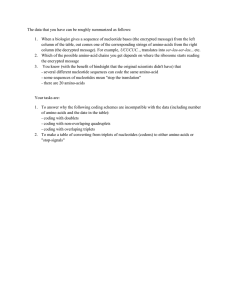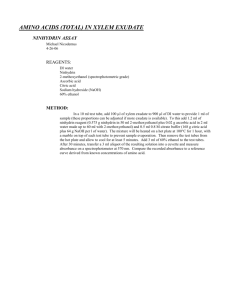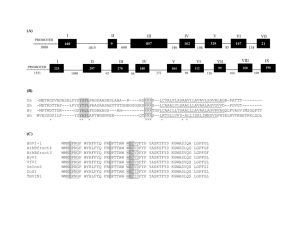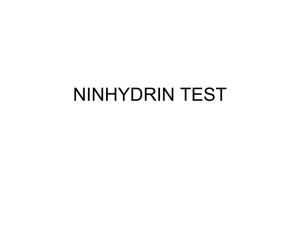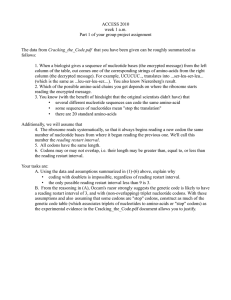best
advertisement
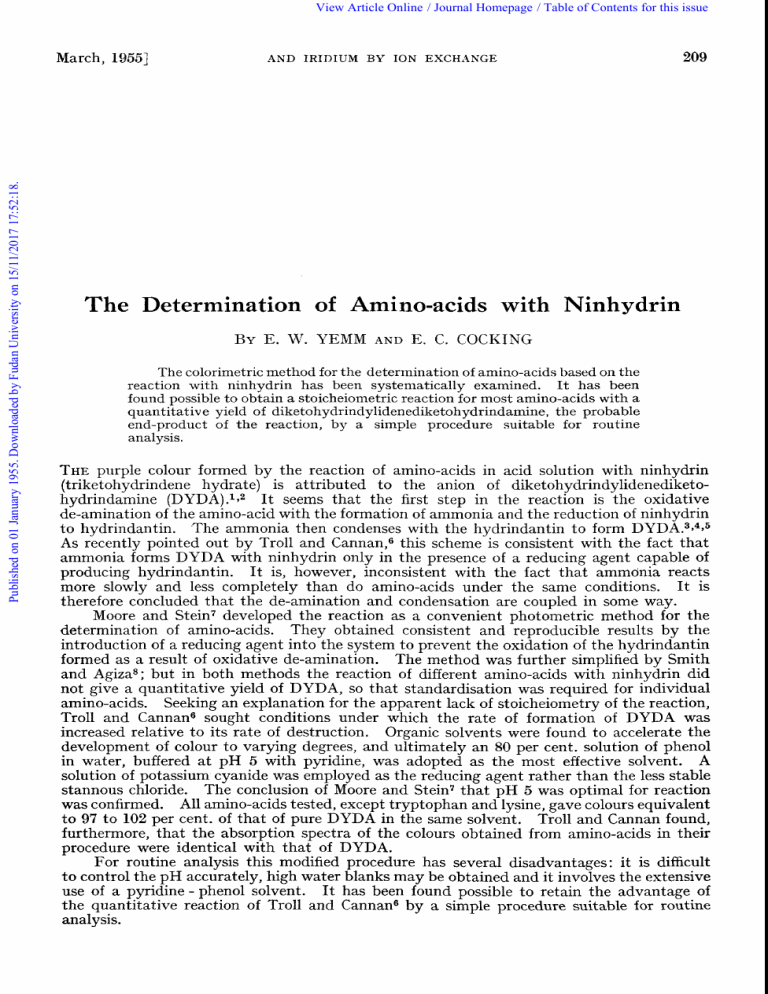
View Article Online / Journal Homepage / Table of Contents for this issue Published on 01 January 1955. Downloaded by Fudan University on 15/11/2017 17:52:18. March, 19551 AND IRIDIUM BY ION EXCHANGE 209 The Determination of Amino-acids with Ninhydrin BY E. IV. YEMM AND E. C. C.OCKING The colorimetric method for the determination of amino-acids based on the reaction with ninhydrin has been systeniatically examined. It has been found possible t o obtain a stoicheiometric reaction for most amino-acids with a quantitative yield of diketohydrindylidenediketohydrindamine,the probable end-product of the reaction, by a simple procedure suitable for routine analysis. THEpurple colour formed by the reaction of amino-acids in acid solution with ninhydrin (triketohydrindene hydrate) is attributed to the anion of diketohydrindylidenediketohydrindamine (DYDA).1,2 It seems that the first step in the reaction is the oxidative de-amination of the amino-acid with the formation of ammonia and the reduction of ninhydrin to hydrindantin. The ammonia then condenses with the hydrindantin to form DYDA.3,4p5 As recently pointed out by Troll and Cannan,6 this scheme is consistent with the fact that ammonia forms DYDA with ninhydrin only in the presence of a reducing agent capable of producing hydrindantin. It is, however, inconsistent with the fact that ammdnia reacts more slowly and less completely than do amino-acids under the same conditions. It is therefore concluded that the de-amination and condensation are coupled in some way. Moore and Stein7 developed the reaction as a convenient photometric method for the determination of amino-acids. They obtained consistent and reproducible results by the introduction of a reducing agent into the system to prevent the oxidation of the hydrindantin formed as a result of oxidative de-amination. The method was further simplified by Smith and Agizas; but in both methods the reaction of different amino-acids with ninhydrin did not give a quantitative yield of DYDA, so that standardisation was required for individual amino-acids. Seeking an explanation for the apparent lack of stoicheiometry of the reaction, Troll and Cannane sought conditions under which the rate of formation of DYDA was increased relative to its rate of destruction. Organic solvents were found to accelerate the development of colour to varying degrees, and ultimately an 80 per cent. solution of phenol in water, buffered a t pH 5 with pyridine, was adopted as the most effective solvent. A solution of potassium cyanide was employed as the reducing agent rather than the less stable stannous chloride. The conclusion of Moore and Stein7 that pH 5 was optimal for reaction was confirmed. All amino-acids tested, except tryptophan and lysine, gave colours equivalent to 97 to 102 per cent. of that of pure DYDA in the same solvent. Troll and Cannan found, furthermore, that the absorption spectra of the colours obtained from amino-acids in their procedure were identical with that of DYDA. For routine analysis this modified procedure has several disadvantages : it is difficult t o control the pH accurately, high water blanks may be obtained and it involves the extensive use of a pyridine - phenol solvent. It has been found possible to retain the advantage of the quantitative reaction of Troll and Cannan6 by a simple procedure suitable for routine analysis. View Article Online 210 YEMM A N D COCKING: T H E D E T E R M I N A T I O N OF [Vol. 80 Published on 01 January 1955. Downloaded by Fudan University on 15/11/2017 17:52:18. METHOD MATERIALSMethyl Cellosolve, CH,OCH;CH,OH-Samples gave a clear solution when mixed with an equal volume of water and a faint or negative peroxide test with 10 per cent. potassium iodide. Ninhydrin-To ensure a low blank reading in the photometric procedure the ninhydrin should be pale yellow with a greenish tint and completely odourless. It should dissolve in methyl Cellosolve to give a clear light yellow solution : if it does not meet these specifications, it may be recrystallised according to the method of Hamilton and or ti^.^ Potassium cyanide-AnalaR reagent as supplied by The British Drug Houses Ltd. Distilled .reater-Treat all distilled water with Permutit to remove traces of ammonia. Amino-acids-For standardisation use synthetic products as far as possible ; recrystallise all amino-acids at least once and dry over concentrated sulphuric acid in vacuo for 48 hours before use. Prepare stock solutions (2 x 10-3M) in 0.1 N hydrochloric acid and store in the cold with a little thymol to prevent fungal growth; prepare standard solutions (2 x M) by dilution with citrate buffer, pH 5 (0-2 M ) . REAGENTSCitrate bufer, p H 5 (0-2M)-Dissolve 21-008g of citric acid, C,H,0,.H20, in 200 ml of distilled water, add 200 ml of N sodium hydroxide and dilute to 500 ml; store in the cold with a little thymol. Potassium cyanide, 0.01 M-Dissolve 0.1628 g of potassium cyanide in distilled water and dilute to 250 ml. This solution is stable for at least 3 months at room temperature. Ethanol in water, 60 per cent. by volume. Potassium cyanide - methyl Cellosolve solution-Dilute 5 ml of 0.01 M potassium cyanide to 250ml with methyl Cellosolve. This solution is stable for a t least 1 month at room temperature. MethyZ Cellosolve - ninhydrin solution-Prepare a 5 per cent. w/v solution of ninhydrin in methyl Cellosolve. This solution is stable for at least 6 months a t room temperature. Potassium cyanide - methyl Cellosolve - ninhydrin solutionlMix 50 ml of the methyl Cellosolve - ninhydrin solution with 250 ml of the potassium cyanide - methyl Cellosolve solution. The resulting solution is at first red, but soon becomes yellow. I t should be stored overnight before use to ensure low blank readings and is stable for at least 1 week when kept in a stoppered flask at room temperature. BLANKDETERMINATIONPreliminary experiments indicated that to ensure low blank readings it was necessary to take precautions against contamination of all solutions by ammonia, especially the pH 5 buffer solution. The blank value at a volume of 5.7 ml, read against water, should not be greater than an optical density of 0.12, if reliable results are to be obtained. PROCEDURE FOR TIETERMINING AMINO-ACIDSMix 0-5ml of citrate buffer, pH 5 (0.2 M), with 1 ml of an amino-acid solution containing 0.05 to 5.6pg of amino nitrogen. Add to this either 0.2 ml of the methyl Cellosolve ninhydrin solution and 1 ml of the potassium cyanide - methyl Cellosolve solution or 1.2 ml of the potassium cyanide - methyl Cellosolve - ninhydrin solution. Heat the well mixed solution for 15 minutes at 100" C, and cool for 5 minutes in running tap water. Make up the solution to a convenient volume with ethanol, shake well, and determine the optical density, using a 1-cm glass cell, on a Unicam spectrophotometer SP500 at 570 m p for all amino-acids. Determine proline and hydroxyproline a t 440 mp. An E.E.L. portable colorimeter (Evans Electroselenium Ltd.) with No. L200 tubes and yellow filter No. 626 (maximum transmission a t a wavelength of 570 mp) is equally satisfactory and much more suitable for routine work involving measurements on a large number of tubes. Proline and hydroxyproline are determined with violet filter No. 621 (maximum transmission at 460 mp). Read all tubes against blanks containing 1.5 ml of citrate buffer, p H 5 (0.2 M ) , and 1-2 ml of the potassium cyanide - methyl Cellosolve - ninhydrin solution subjected to the same procedure as above. Preliminary experiments indicated that the heating time View Article Online March, 19551 211 AMINO-ACIDS W I T H NIN H Y D R I N Published on 01 January 1955. Downloaded by Fudan University on 15/11/2017 17:52:18. was not critical and that most amino-acids had reacted fully after heating a t 100"C for 10 minutes. Furthermore, the boiling point of the water - methyl Cellosolve mixture is greater than 100"C; using tubes stoppered with a glass marble, evaporation gave losses during the heating period that were negligible. The colour was stable at room temperature for at least 3 hours before ethanol was added and for at least 1 hour after its addition. ISOLATION OF PURE DYDA DYDA was isolated, as its sodium salt, from aqueous solution by the method of Moore and Stein.' For analysis 50 mg of the sodium salt was recrystallised from 15 ml of a water rt-propanol mixture (1 1). The crystals were dried over concentrated sulphuric acid in vacuo for 48 hours, and the millimolar extinction coefficient at 5 7 0 m p was determined in the same solvent mixture as employed in the procedure described above. It wasfound to be 21.6 and is in agreement with that found by Troll ar.d Cannan6 for the sodium salt of DYDA in a solution of pyridine, phenol and ethanol; and, as was also found by Troll and Cannan, the absorption spectrum of the sodium salt was identical with that of the unfractionated reaction mixture obtained from amino-acids in the ninhydrin analysis. + RESULTS For each of the amino-acids various amounts containing from about 0.1 to 6 4 p g of amino nitrogen were examined by the above procedure. The standard curves determined by using an E.E.L. colorimeter for amino-acids in the concentration range 0-05 to 2.8 pg of amino nitrogen are shown in Fig. 1. The individual readings were reproducible to within 1 per cent. of the mean of four determinations for all amino-acids studied. From optical density measurements on the spectrophotometer the millimolar extinction coefficient of the reaction mixture, a t 570 mp, was calculated in each case, and since that of the sodium salt of DYDA was known the percentage yield of DYDA could be determined. The results are summarised in Table I. TABLEI EXTINCTION COEFFICIENTS A N D ESTIMATED YIELDS OF Amino-acid Rlanine . . Arginine . . Aspartic acid Asparagine Cysteic acid Cystine . . Glutamic acid Glutamine Glycine . . Histidine. . Leucine . . isoLeucine Lysine . . Methionine Serine .. Threonine Tryptophan .. Valine Phenylalanine Tyrosine . . Ammonia .. .. .. .. .. .. .. .. .. .. .. .. .. .. .. .. .. .. .. .. .. .. .. .. .. .. .. .. .. .. .. .. .. .. .. .. .. .. .. .. .. .. .. .. .. .. .. .. DYDA Millimolar extinction coefficient at 570 m p Yield of DYDA, .. .. .. .. .. .. .. .. .. .. .. .. .. .. .. .. .. .. .. .. .. .. .. .. .. .. .. .. .. .. .. .. .. .. .. 21-6 21.6 21.6 9-7 21.4 21.6 21-6 21-6 21.6 21.6 21-6 21.6 23-4 21.6 21.4 21.6 18.0 21.4 19.1 19.1 7.1 % 100 100 100 45 99 100 100 100 100 100 100 100 108 100 99 100 83 99 89 89 33 It was found that all the amino-acids studied gave colours equivalent to 100 1 per cent. of that of pure DYDA except tyrosine and phenylalanine (89 per cent.), tryptophan (83 per cent.) and lysine (108 per cent.). Ammonia reacted to yield a colour equivalent to only 33 per cent. of that of pure DYDA. This value for ammonia is, however, approximate and varies somewhat from one batch of reagent to another. Proline and hydroxyproline react with ninhydrin in an entirely different way; de-amination does not occur, no DYDA is produced, reducing agents are without influence and the imino-acid residue that results View Article Online Published on 01 January 1955. Downloaded by Fudan University on 15/11/2017 17:52:18. 212 [Vol. 80 YEMM AND COCKING: THE DETERMINATION OF 0 0.5 I .o I *5 2.0 2.5 3.0 Amino nitrogen, pg Fig. 1. Standard graphs determined on colorimeter with reaction mixture adjusted to 5.7 mlA, lysine; B, alanine, arginine, aspartic acid, cysteic acid, cystine, glutamic acid, glycine, histidine, leucine, isoleucine, methionine, serine, threonine and valine ; C, phenylalanine and tyrosine ; D, tryptophan; E, proline DISCUSSION OF RESULTS It is clear from the results shown that a stoicheiometric reaction occurs for most of the amino-acids studied, with a quantitative yield of DYDA. The low yield with tryptophan is to be expected, since the optimum pH for reaction is in this case 6, and the high yield for lysine is probably brought about by the partial reaction of the terminal amino group. The yield of DYDA from tyrosine and phenylalanine is largely dependent on the relative proportion of water to methyl Cellosolve, for it is found that the reaction is almost complete when the relative proportion of water to methyl Cellosolve is increased from 1 :0.8 to 1 :0.4. The yields with the procedure described are however quite reproducible. The results for cystine indicate that only one-half of the amino groups react; it seems probable that one reacts and that the other is protected by cyclisation. Cysteine is known to be the only amino-acid that does not form DYDA; from it a yellow product similar to that given by Cysteic acid on the other hand reacts normally. proline is The procedure described above has several advantages over that of Moore and Stein.' The more complete reaction gives greater sensitivity and highly reproducible results , whilst the lower sensitivity to ammonia leads to smaller and more consistent blanks. Moreover a shorter and less critical heating period is required. There is also a considerable economy of ninhydrin, for only about one-half of the quantity is required compared with that used in the method of Moore and Stein, and furthermore the method avoids the complication of having to store reduced ninhydrin under nitrogen. APPLICATIONTO PROTEIN HYDROLYSATES The procedure described was developed for the estimation of the amino-acids of protein hydrolysates separated chromatographically on ion-exchange resin columns by elution with buffers of progressively increasing pH, as in the method of Moore and Stein.ll One-millilitre View Article Online Published on 01 January 1955. Downloaded by Fudan University on 15/11/2017 17:52:18. March, 19551 AMINO-ACIDS W I T H N I N H Y U R I N 213 fractions of effluent were obtained in optically matched tubes by using a capacity-change drop counter. Each fraction was treated with 0 6 m l of citrate buffer, pH 5 ( 0 - 2 M ) , to which N sodium hydroxide had been,added so that the final pH of the treated fraction was 5. Then 1-2ml of the potassium cyanide - methyl Cellosolve - ninhydrin solution were added as in the standard procedure. The tubes were well shaken and heated in racks of twenty-five a t 100" C for 15 minutes. They were cooled in running tap water for 5 minutes, 3 ml of ethanol were added, the tubes were shaken and the colour intensity was read directly in an E.E.L. colorimeter, a No. 626 filter being used. I n view of the low absorption of DYDA a t 440 m p it has been found possible to estimate proline when mixed with small quantities of other amino-acids. This is readily achieved on an E.E.L. colorimeter, No. 621 and 626 filters being used. No interference was noted from special chemicals such as benzyl alcohol, thiodiglycol and ethylenediaminetetra-acetic acid added to the columns to improve their performance. The complete reaction makes possible the more accurate calculation of the amount of an amino-acid present when one peak is incompletely separated from another; moreover, the low yield from ammonia ensures lower and inore consistent blank readings, thus making possible the more exact determination of the amount of an amino-acid present under any particular peak. With the above procedure it has been found possible by using semi-automatic pipettes to analyse 100 samples in about 3 hours. One of us (E. C. C.) is indebted to the Agricultural Research Council for a Research Studentship. REFERENCES 1. MacFadyen, D. X., J . B i o l . Chem., 1950, 186, 1. 2. MacFadyen, D. A., and Fowler, N., Ibid., 1950, 186, 13. 3. Ruhemann, S., J . Chem. SOC.,1910, 97, 1438. Ibid., 1911, 99, 792. 4. -, I b i d . , 1911, 99, 1486. 5. -, 6. Troll, W., and Cannan, R. K., J . B i o l . Chem., 1953, 200, 803. 7. Moore, S., and Stein, W. H., Ibid., 1948, 176, 367. 8. Smith, A. M., and Agiza, A. H., Analyst, 1951, 76, 623. 9. Hamilton, P. B., and Ortiz, P. J., Anal. Chem., 1950, 22, 948. 10. Grassman, W., and von Arnim, K., Annalen, 1934, 509, 288. 11. Moore, S., and Stein, W. H., J . Biol. Chem., 1951, 192, 663. DEPARTMENT OF BOTANY ~JNIVERSITY OF BRISTOL 4ugust 3vd, 1954 Appendix A CAPACITY-CHANGE DROP COUNTER BY R. E. RICKETTS A SIMPLY constructed and reliable capacity-change drop counter is described. Fractions of 1 to 5 ml may be automatically collected, and measurements made over a period of several months indicate an accuracy of delivery better than f l per cent. I t was found necessary to collect a large number of fractions of eluate from resin columns employed for the fractionation of protein hydrolysates. The equipment used was designed to operate in conjunction with a chromatographic table,l a sct number of drops being counted into each test tube. In view of the possibility of breakdown of unstable solutions owing to electrical contact, it was decided to use a capacity-operated switch. To guard against failure of valves or other components, two channels operating simultaneously were used, with "test channel" buttons to enable the operator to check, periodically, each channel separately. The circuit diagram of the apparatus is shown in Fig. 2. Valves V, and V, are connected as a Hartley oscillator whose feedback depends on the ratio of C, and C,. Radio-frequency voltage from the oscillator is applied through C, to the thyratrons, V, and V,. The supply voltage to the oscillator is arranged to be 180" out of phase with that applied to the thyratrons, consequently rectification occurs a t the grids of the thyratrons so charging C, negatively, thus biasing the View Article Online Published on 01 January 1955. Downloaded by Fudan University on 15/11/2017 17:52:18. 214 YEMM AND COCKING pol. 80 thyratrons and ensuring that no current passes through the counting relay. As a drop approaches the platinum wires which form C,, the critical value is upset, oscillation ceases, the bias is removed and the counting relay is energised. A t some pre-determined number of drops the counting relay in turn energises the table relay by discharging a 32-pF condenser, and the next tube moves into place. REFERENCE 1. Hough, L., Jones, J . K. N., and Wadman, W. H., J. Chem. Soc., 1949, 2511. CHEMISTRY DEPARTMENT OF BRISTOL UNIVERSITY August 3rd, 1954
